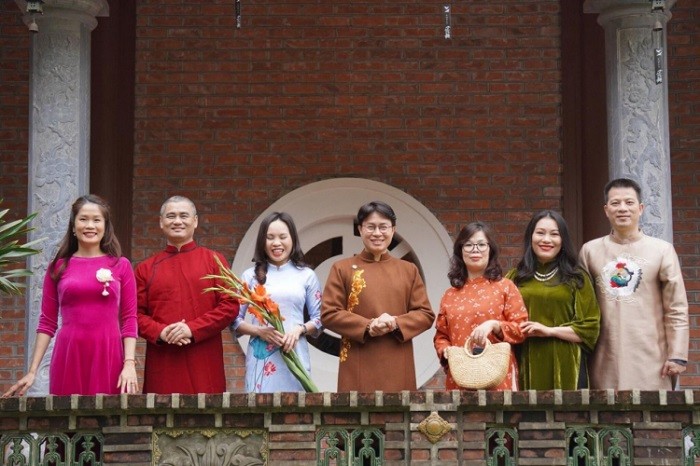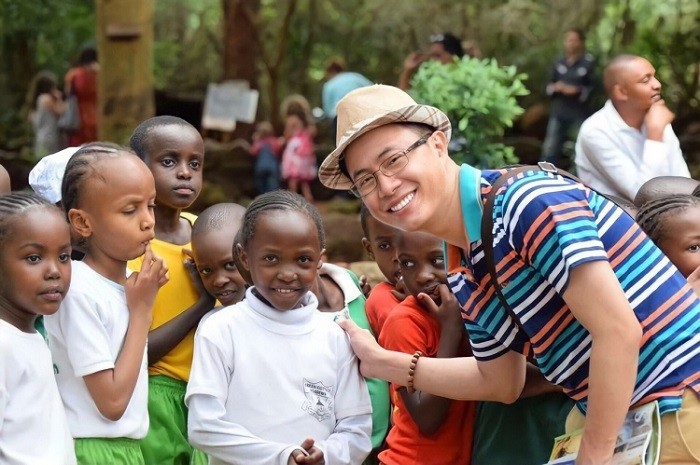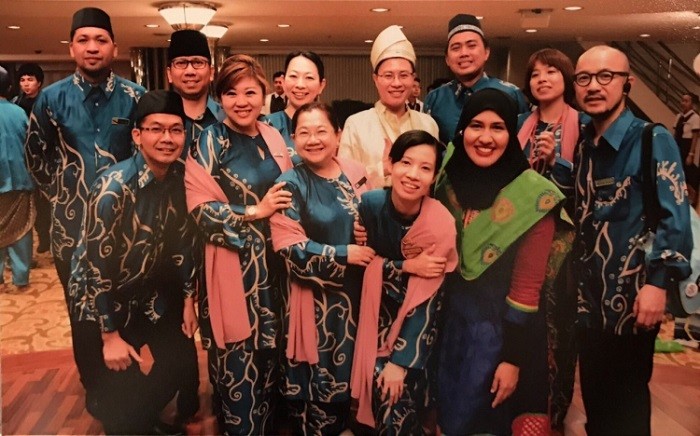
Dr. Trinh Le Anh: Substantial investment is required to make MICE tourism a 'specialty' of Vietnam
Latest
 |
| According to Dr. Trinh Le Anh (in the middle), the potential of MICE tourism is huge, but Vietnam has only exploited a small part. (Photo by Dr. Trinh Le Anh sent) |
That is the view of Dr. Trinh Le Anh, Vice President of Vietnam Mice Club - VMC (under the Vietnam Tourism Association); Head of Event Management Department, Faculty of Tourism, University of Social Sciences and Humanities, Vietnam National University, Hanoi, regarding the development of MICE tourism in Vietnam.
How do you evaluate the strengths and potentials of developing MICE tourism?
In recent years, Vietnam’s position and prestige have been increasingly enhanced. The success of the tourism industry has contributed to improving competitiveness and raising Vietnam’s tourism brand in the international arena, thereby promoting economic, political, cultural, and sports events and developing MICE tourism (Meetings-Incentives-Conventions-Exhibitions/Events). Vietnam has many advantages for the development of MICE tourism.
Regarding MICE tourism development policy, Vietnam’s tourism development strategy to 2030 defines the goal of “Vietnam ranking among three leading countries in terms of tourism development in Southeast Asia and among top 50 nations with the highest tourism competitiveness in the world. Moreover, all 14 criteria of tourism competitiveness are projected to increase and be in line with the requirements of sustainable development.”
The strategy focuses on developing MICE, sports, and healthcare tourism to attract both international and domestic tourists. The domestic destinations that develop MICE tourism are clearly stated, including Hanoi, Quang Ninh, Da Nang, Khanh Hoa and Ho Chi Minh City.
In 2020, Vietnam developed and published the National Standard on MICE Tourism-venue requirements for hotels.
With regard to tourism accommodation facilities, in 2019, our accommodation facility system made valuable contributions to serving major events of the industry and the country such as the US-North Korea Summit in Hanoi, the ASEAN Tourism Forum (ATF) 2019 in Ha Long, United Nations Day of Vesak 2019 and many other important events. Through these programs, Vietnam’s role, status and ability in hosting major international events have been convincingly demonstrated.
In 2020, at the Awards Ceremony of ASEAN Tourism Forum 2020 (ATF) held in Brunei (January 16), within the framework of the week of Southeast Asia Tourism Forum, many tourist accommodation establishments of Vietnam were awarded the ASEAN MICE Venue Award - Award for the hotels with the best conference venues. These hotels included Furama Resort (Da Nang), Van Phat Riverside (Can Tho), Muong Thanh Luxury (Quang Ninh), Diamond Bay (Khanh Hoa), Novotel Phu Quoc (Kien Giang).
It is forecasted that by 2025, the MICE tourism industry alone will earn over $1.4 trillion, and the two “bright spots” are Europe and Asia-Pacific.
In particular, right before the outbreak of the COVID-19 epidemic, Vietnam emerged as the leading MICE tourist destination in the region. According to professionals’ calculations, the average proportion of MICE visitors at travel agencies is 15-20%; at large agencies, this figure can reach 60% in peak months.
It is worth noting that European MICE visitors account for about 20% and are identified as high-class customers, with a spending level of 700-1,000 USD/day, while Asian visitors spend more than 400 USD/day.
After COVID-19, it is estimated that MICE tourism is a “fertile land” of Vietnamese tourism when there is still a lot of room for development. It can be seen that MICE is a potential stream of high-quality tourists that can be taken advantage of in the coming time, when the epidemic is under control - a period that is considered to witness a boom in tourism. It is especially true for MICE - a type of tourism that effectively combines work and wanderlust which has been constricted for a long time.
Tourists participating in MICE tourism are inherently more high-class than regular tourist groups. Therefore, do the promotion and utilization of this form of tourism have to change?
Obviously, the demand and potential of MICE tourism is significant, but Vietnam has only exploited a small part. Businesses need to closely link with each other and with local authorities to promote their strengths from tourism promotion activities with an aim to serve a huge number of MICE visitors who require outstanding professionalism.
 |
| Dr. Trinh Le Anh on a business trip to Africa. (Photo by Dr. Trinh Le Anh sent) |
In Vietnam, when the pandemic is under control, many organizations and businesses have enhanced their engagement activities, skills training, investment promotion, and organized conferences in combination with sightseeing and exploring landscapes as well as cultural characteristics, etc. after two years of restriction.
Since then, MICE tourism has been thriving to “make up” for the previous shortage. However, this is a type of tourism that requires professionalism, connectivity, and strict selection of destinations and products. The exploitation and development of this product line in Vietnam is facing numerous challenges.
Vietnam currently boasts a lot of 5-star hotels, but the number of rooms and room capacity are still insignificant; moreover, there are not many conference and exhibition centers that meet the requirements of organizing events for large groups of several thousand participants.
Meanwhile, human resources for MICE tourism are limited in both quantity and quality. On top of that, the promotion of this type of tourism to the international market is still insignificant and trivial.
It can be seen that the biggest current challenge is the lack of personnel, even though companies are constantly recruiting new employees. Lots of MICE-specialized enterprises have to offer high salaries to attract tourism personnel who have switched to other industries and provide rapid training for students majoring in tourism.
Along with the human resource problem, the lack of working capital also puts pressure on MICE businesses because accommodation facilities, restaurants, and transportation agencies all require deposits. What’s more, during the peak season, when service providers have not fully reopened, the services can not be offered even though there are customers and money.
Therefore, in order for MICE tourism to truly become a “specialty” of Vietnam's tourism, localities, businesses, and destinations are required to continue to make considerable investments, deploy synchronous solutions, implement effective coordination with relevant industries and services. Furthermore, investment attraction and promotion activities should be boosted so that this type of tourism can be accelerated in the coming time.
How have ASEAN countries been developing this form of tourism and what can Vietnam learn from them?
I would like to bring up the case of Singapore - a country with a world-class MICE tourism and is worth learning about. Singapore has designed a strategy to develop MICE tourism and determined to make it a leading power in Asia in terms of travel & tourism conferences.
 |
| Dr. Trinh Le Anh and leaders of the Ship for Southeast Asian and Japanese Youth Program participated in a conference in Japan in 2016. (Photo by Dr. Trinh Le Anh sent) |
At the same time, Singapore will develop into a service and resort center of the region. This strategy identifies major tourism projects that need to be implemented such as Formula OneTM Singapore Grand Prix, Integrated Resorts and Singapore Flyer.
With the advantages of geographical location, modern infrastructure system, and being the center of key trade activities in the region, Singapore identifies MICE tourism development as the focus of its tourism product development strategy.
Since 1971, the country has promoted itself as the “Convention Center of the East” and established Singapore Convention Bureau - SCB in 1974 with the task of fostering awareness about Singapore - the best MICE destination in Asia.
Having determined the goal, Singapore has cooperated with the world’s leading hotels to develop convention centers and with private investors to develop modern technical facilities. By the end of the 1990s, Singapore had the necessary infrastructure and technical facilities to host world-class MICE events such as the Suntec Singapore International Convention, the Exhibition Center and the Singapore Expo.
In 1996, SCB changed its name to Singapore Exhibition & Convention BureauTM (SECB) to expand into the field of exhibition organization. Moreover, the agency has joined hands with business partners in the fields of event organization and travel to improve the quality of MICE travel experience for customers who are business travelers.
Currently, Singapore has become the world’s leading destination for MICE tourism, which contributes more than 30% to the country’s total tourism revenue. However, this country still strives to change and develop constantly in order to maintain its leading position.
19 years ago, Thai people knew nothing about MICE. At present, they are proud to be the country giving birth to that name and have clearly shaped the development roadmap of this industry with the ambition to be the MICE center in Southeast Asia.
To put it more simply, in addition to continuing to attract groups of tourists to Thailand with the need for personal travel experiences (they may only come once in a lifetime), Thailand is more focused on the goal of attracting delegations to their home countries for events and seminars, and travelling is just a part of those business trips.
MICE Industry is the name coined by Thailand in the process of developing this tourism service for the past 22 years. They named it like that to distinguish it from industries with similarities such as the Event Industry of the US or the Meeting Industry of Europe.
With the motto of creating maximum convenience for visitors from the moment they arrive to the time they leave Thailand, the “MICE ecosystem” gathers around it large event centers, 5-star hotels and resorts in Bangkok, Pattaya and the surrounding areas which are within 2-3 hours’ drive from the capital.
Participating in MICE are major airlines such as Thai Airways and Bangkok Airways. Not only enjoying the discount on fares and baggage weight, right from the moment they step off the airport of Thailand, MICE travelers will immediately experience private services, such as shortened check-out paths.
Moreover, Thailand organizes other major MICE attraction campaigns such as “MICE Thailand Signature” with 262 stores offering discounts of up to 30% for MICE visitors. These 262 stores belong to 6 business groups: health; cuisine; coffee and bar; shopping; entertainment and cultural shows, and classes (muay Thai, Thai cuisine).
Obviously, Thai people have integrated numerous industries, businesses, business categories and experiences in one MICE industry. All of these organizations are associated with the travelling, eating, sleeping, experiencing, working, and entertainment activities of foreign guests.
Thank you, Dr. Trinh Le Anh!




















